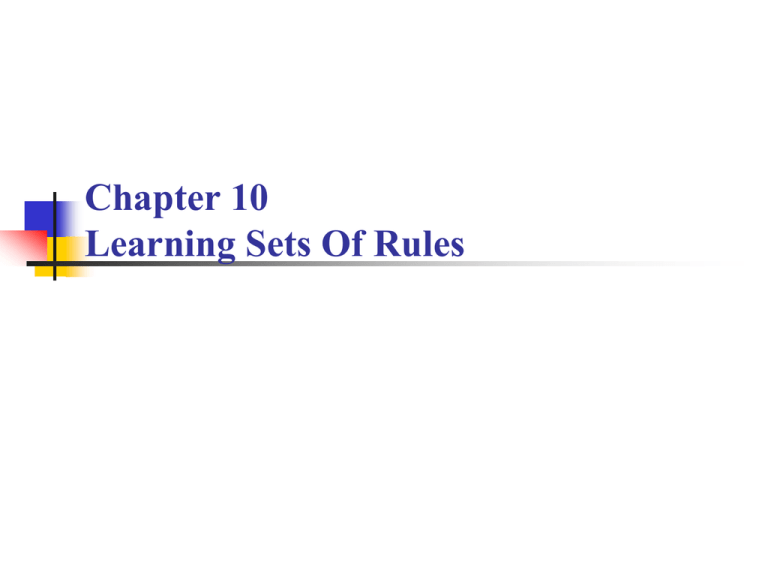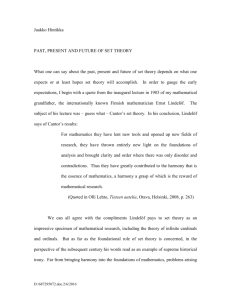Chapter 10 Learning Sets Of Rules
advertisement

Chapter 10
Learning Sets Of Rules
Content
Introduction
Sequential Covering Algorithm
Learning First-Order Rules
(FOIL Algorithm)
Induction As Inverted Deduction
Inverting Resolution
Introduction
GOAL: Learning a target function as a set of IF-THEN rules
BEFORE: Learning with decision trees
Learning the decision tree
Translate the tree into a set of IF-THEN rules (for each leaf
one rule)
OTHER POSSIBILITY: Learning with genetic algorithms
Each set of rule is coded as a bitvector
Several genetic operators are used on the hypothesis space
TODAY AND HERE:
First: Learning rules in propositional form
Second: Learning rules in first-order form (Horn clauses which
include variables)
Sequential search for rules, one after the other
3
Introduction
IF (Outlook = Sunny) ∧ (Humidity = High)
THEN PlayTennis = No
IF (Outlook = Sunny) ∧ (Humidity = Normal)
THEN PlayTennis = Yes
Introduction
An example of first-order rule sets
target concept: Ancestor
IF Parent(x,y)
THEN Ancestor(x,y)
IF Parent(x,y)∧ Parent(y,z)
THEN Ancestor(x,z)
The content of this chapter
Learning algorithms capable of learing such
rules , given sets of training examples
Content
Introduction
Sequential Covering Algorithm
Learning First-Order Rules
(FOIL Algorithm)
Induction As Inverted Deduction
Inverting Resolution
Sequential Covering Algorithm
Sequential Covering Algorithm
Goal of such an algorithm:
Learning a disjunctive set of rules, which defines a preferably good
classification of the training data
Principle:
Learning rule sets based on the strategy of learning one rule,
removing the examples it covers, then iterating this process.
Requirement for the Learn-One-Rule method:
As Input it accepts a set of positive and negative training
examples
As Output it delivers a single rule that covers many of the
positive examples and maybe a few of the negative examples
Required: The output rule has a high accuracy but not
necessarily a high coverage
8
Sequential Covering Algorithm
Procedure:
Learning set of rules invokes the Learn-One-Rule method on
all of the available training examples
Remove every positive example covered by the rule
Eventually short the final set of the rules: more accurate rules
can be considered first
Greedy search:
It is not guaranteed to find the smallest or best set of rules
that covers the training example.
9
Sequential Covering Algorithm
SequentialCovering( target_attribute, attributes, examples, threshold )
learned_rules { }
rule LearnOneRule( target_attribute, attributes, examples )
while (Performance( rule, examples ) > threshold ) do
learned_rules learned_rules + rule
examples examples - { examples correctly classified by rule }
rule LearnOneRule( target_attribute, attributes, examples )
learned_rules sort learned_rules according to Performance over
examples
return learned_rules
10
General to Specific Beam Search
The CN2-Algorithm
LearnOneRule (target_attribute, attributes, examples, k )
Initialise best_hypothesis to the most general hypothesis Ø
Initialise candidate_hypotheses to the set { best_hypothesis }
while ( candidate_hypothesis is not empty ) do
1. Generate the next more-specific candidate_hypothesis
2. Update best_hypothesis
3. Update candidate_hypothesis
return a rule of the form “IF best_hypothesis THEN prediction“
where prediction is the most frequent value of target_attribute among those
examples that match best_hypothesis.
Performance( h, examples, target_attribute )
h_examples the subset of examples that match h
return -Entropy( h_examples ), where Entropy is with respect to
target_attribute
11
General to Specific Beam Search
'
Generate the next more specific candidate_hypothesis
all_constraints set of all constraints (a = v), where a attributes and
v is a value of an occuring in the current set of examples
new_candidate_hypothesis
for each h in candidate_hypotheses,
for each c in all_constraints
create a specialisation of h by adding the constraint c
Remove from new_candidate_hypothesis any hypotheses which are
duplicate, inconsistent or not maximally specific
Update best_hypothesis
for all h in new_candidate_hypothesis do
if statistically significant when tested on examples
Performance( h, examples, target_attribute )
> Performance( best_hypothesis, examples, target_attribute ) )
then best_hypothesis h
12
General to Specific Beam Search
Update the candidate-hypothesis
candidate_hypothesis the k best members of new_candidate_hypothesis,
c
according to Performance function
Entropy s = pi log 2 pi
i=1
'
Performance function guides the search in the Learn-One -Rule
O
s: the current set of training examples
O
c: the number of possible values of the target attribute
O
p i : part of the examples, which are classified with the ith. value
13
Learn-One-Rule
Learning Rule Sets: Summary
Key dimension in the design of the rule
learning algorithm
Here sequential covering: learn one rule, remove the positive examples
covered, iterate on the remaining examples
ID3 simultaneous covering
Which one should be preferred?
Key difference: choice at the most primitive step in the search
ID3: chooses among attributes by comparing the partitions of the data
they generated
CN2: chooses among attribute-value pairs by comparing the subsets of
data they cover
Number of choices: learn n rules each containing k attribute-value tests in their
precondition
CN2: n*k primitive search steps
ID3: fewer independent search steps
If the data is plentiful, then it may support the larger number of independent
decisons
If the data is scarce, the sharing of decisions regarding preconditions of different
rules may be more effective
15
Learning Rule Sets: Summary
CN2: general-to-specific (cf. Find-S specific-to-general):the direction
of the search in LEARN-ONE-RULE.
Advantage: there is a single maximally general hypothesis
from which to begin the search <=> there are many specific
ones
GOLEM: choosing several positive examples at random to
initialise and to guide the search. The best hypothesis
obtained through multiple random choices is the selected one
CN2: generate then test
Find-S, CANDIDATE-ELIMINATION are example-driven
Advantage of the generate and test approach: each choice in
the search is based on the hypothesis performance over
many examples, the impact of noisy data is minimized
16
Content
Introduction
Sequential Covering Algorithm
Learning First-Order Rules
(FOIL Algorithm)
Induction As Inverted Deduction
Inverting Resolution
Learning First-Order Rules
Why do that ?
Can learn sets of rules such as
IF Parent(x,y)
THEN Ancestor(x,y)
IF Parent(x,y)∧Ancestor(y,z)
THEN Ancestor(x,z)
Learning First-Order Rules
Terminology
Term : Mary , x , age(Mary) , age(x)
Literal : Female(Mary), ﹁Female(x)
Greater_than(age(Mary) ,20)
Clause : M1∨…∨Mn
Horn Clause: H←(L1∧…∧Ln)
Substitution : {x/3,y/z}
Unifying substitution:
=
FOIL Algorithm
(Learning Sets of First-Order Rules)
Cover all positive examples
Avoid all negative examples
Learning First-Order Rules
Analysis of FOIL
Outer Loop
Specific-to-general
Inner Loop
general-to-specific
Difference between FOIL and Sequential- covering
and Learn-one-rule
generate candidate specializations of the rule
FOIL_Gain
Learning First-Order Rules
Candidate Specializations in FOIL
(Ln+1)
Learning First-Order Rules
Example
Target Predicate : GrandDaughter(x,y)
Other Predicate: Father , Female
Rule : GrandDaughter(x,y)
Candidate Literal:
Equal(x,y) ,Female(x),Female(y),Father(x,y),Father(y,x),
Father(x,z),Father(z,x), Father(y,z), Father(z,y) + negative Literals
GrandDaugther(x,y)
GrandDaughter(x,y)
Father(y,z)
Father(y,z) ∧Father(z,x) ∧Female(y)
Learning First-Order Rules
Information Gain in FOIL
Assertions of training data
GrandDaughter(Victor,Sharon)
Father(Sharon,Bob)
Father(Tom,Bob) Female(Sharon) Father(Bob,Victor)
Rule : GrandDaughter(x,y)
Variable binding (16): {x/Bob , y/Sharon}
Positive example binding: {x/Victor , y/Sharon}
Negative example binding (15): {x/Bob,y/Tom} ……
Learning First-Order Rules
Information Gain in FOIL
L
p0
n0
p1
n1
t
the candidate literal to add to rule R
number of positive bindings of R
number of negative bindings of R
number of positive bindings of R+L
number of negative bindings of R+L
the number of positive bindings of R also
covered by R+L
Learning First-Order Rules
Learning Recursive Rule Sets
Target Predicate can be the candidate literals
IF Parent(x,y)
THEN Ancestor(x,y)
IF Parent(x,y)∧Ancestor(y,z)
THEN Ancestor(x,z)
Learning First-Order Rules
Learning Recursive Rule Sets
Target Predicate can be the candidate literals
IF Parent(x,y)
THEN Ancestor(x,y)
IF Parent(x,y)∧Ancestor(y,z)
THEN Ancestor(x,z)
Content
Introduction
Sequential Covering Algorithm
Learning First-Order Rules
(FOIL Algorithm)
Induction As Inverted Deduction
Inverting Resolution
Induction As Inverted Deduction
Machine Learning
Building theories that explain the observed data
( D <xi , f(xi)> ; B ; h )
Induction is finding h such that
entail
Induction As Inverted Deduction
Example
target concept : Child(u , v)
Induction As Inverted Deduction
What we will be interested is designing
inverse entailment operators
Content
Introduction
Sequential Covering Algorithm
Learning First-Order Rules
(FOIL Algorithm)
Induction As Inverted Deduction
Inverting Resolution
Inverting Resolution(逆规约)
C1
C2
C
Resolution operator construct C :
( C1 ∧ C2
C)
Inverse resolution operator : O( C , C1 )=C2
Inverting Resolution
First-order resolution
C1 S wa n( x ) Wh ite ( x )
C 2 S wa n( Fred )
{ x / Fred}
L1 L2 S wa n( Fred )
Resolution operator (first-order):
C White(Fred)
Inverting Resolution
Inverting First order resolution
1 2
Inverse resolution (first-order )
Inverting Resolution
Example
target predicate : GrandChild(y,x)
C
D = { GrandChild(Bob,Shannon) }
B = {Father(Shannon,Tom) , Father(Tom,Bob)}
1 {}
C1
L1
12 {Shannon/ x}
C 2 GrandChild(Bob,x) Father(x,
Tom)
GrandChild(Bob,x) Father(x,
Tom)
Inverting Resolution
C1
C2
C
Summary
Sequential covering algorithm
Propositional form
first-order (FOIL algorithm)
A second approach to learning first-order
rules -- Inverting Resolution









